Oct
14
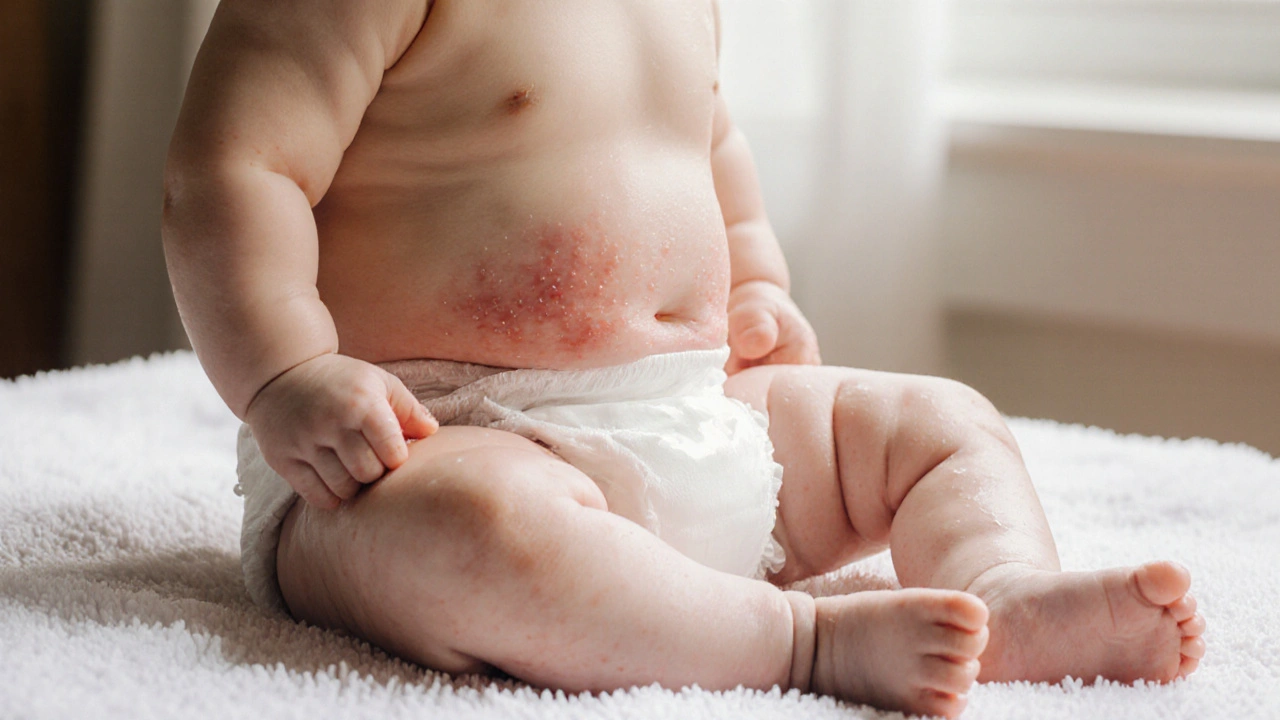
- by Gareth Harington
- 4 Comments
Diaper Rash vs Eczema Checker
This tool helps you identify whether your baby's rash is most likely diaper rash or eczema based on key symptoms. It's not a substitute for professional medical advice, but it can help you understand what you're seeing and when to consult a pediatrician.
Enter your answers above and click "Check My Baby's Rash" to see if it's likely diaper rash or eczema.
Key Takeaways
- Diaper rash and baby eczema often share the same underlying skin‑barrier problems.
- Both conditions can be triggered by moisture, friction, and irritants, but they differ in location, appearance, and chronicity.
- Simple daily routines-frequent changes, gentle cleansing, and barrier protection-help prevent most flare‑ups.
- When symptoms persist beyond a few days, or when you see cracks, ooze, or fever, see a pediatrician.
What Is Diaper Rash?
When a baby’s bottom becomes red and sore, diaper rash is a common form of skin irritation that occurs in the diaper area due to moisture, friction, and irritants. The rash usually appears within the first few months of life, when the diaper is in constant contact with warm, damp skin.
The main culprits are:
- Prolonged exposure to wetness, which softens the outer layer of skin (the stratum corneum).
- Friction from the diaper edges that breaks the skin’s protective barrier.
- Urine and feces, which contain enzymes and salts that irritate the skin.
- Secondary infection by yeast (Candida) that thrives in warm, moist environments.
Because the cause is often environmental, most diaper‑rash cases resolve quickly with proper hygiene and barrier protection.
What Is Baby Eczema (Atopic Dermatitis)?
Baby eczema, medically known as atopic dermatitis, is a chronic inflammatory skin condition that can appear anywhere on an infant’s body, most commonly on the cheeks, forearms, and the flexural surfaces of elbows and knees.
Unlike diaper rash, eczema is driven by a combination of genetic predisposition, immune system over‑reaction, and a compromised skin barrier that lets allergens and irritants penetrate more easily. The result is dry, itchy patches that can become red, scaly, or weepy.
While the exact cause is still being studied, research shows that mutations in the filaggrin gene-key for maintaining a strong barrier-are present in up to 30% of infants with eczema.
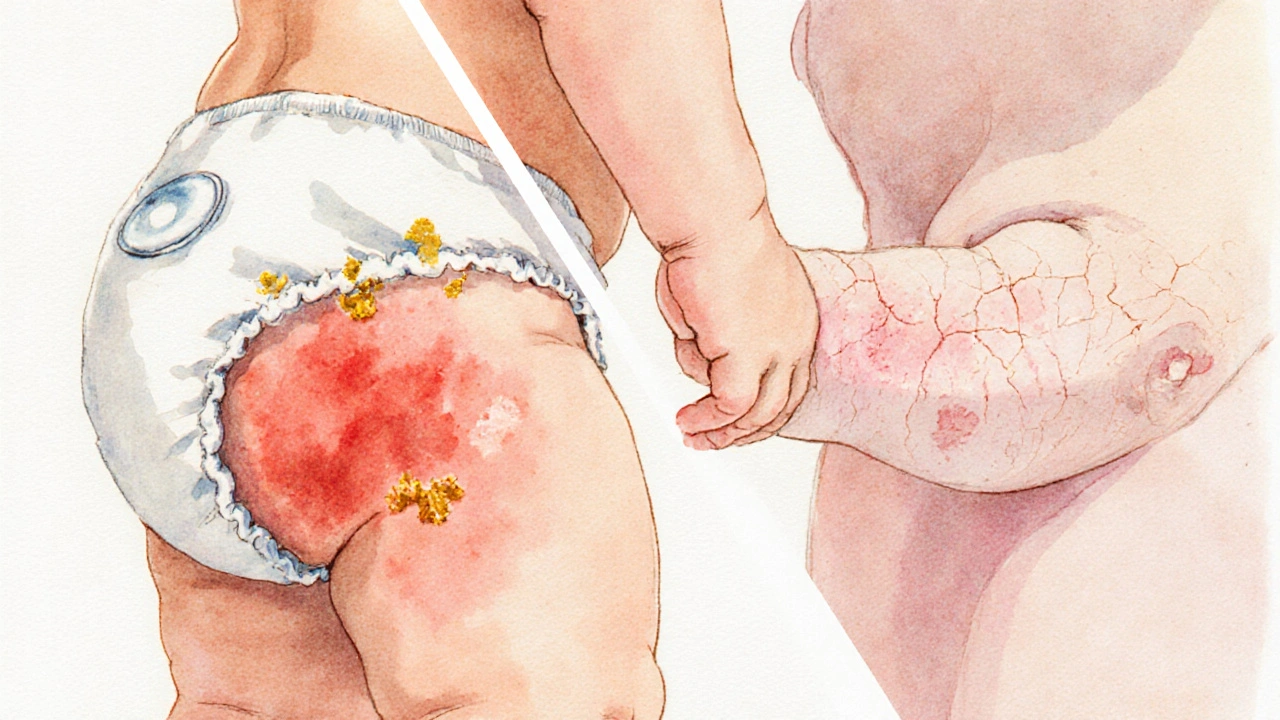
How the Two Conditions Overlap
Both diaper rash and baby eczema share three core risk factors:
- Moisture: Excess water softens the outer skin layer, making it easier for irritants to enter.
- Friction caused by tight or ill‑fitting diapers can also aggravate eczema patches that happen to be in the diaper area.
- Irritants such as scented wipes, soaps, or laundry detergents can trigger both conditions.
Because of this overlap, it’s not unusual for a baby with a history of eczema to develop a more stubborn diaper rash, and vice‑versa. The key difference lies in where the problem shows up and how long it lasts.
Spotting the Differences: Symptoms & Diagnosis
Here’s a quick visual guide to tell the two apart:
| Feature | Diaper Rash | Baby Eczema |
|---|---|---|
| Typical Location | Only inside the diaper area (genitals, buttocks, inner thighs) | Anywhere-face, scalp, elbows, knees, even diaper area |
| Appearance | Red patches, sometimes with raised bumps; may develop yellowish crusts if infection occurs | Dry, scaly patches that are intensely itchy; may become oozing or crusted during flare‑ups |
| Duration | Usually resolves in 2‑5 days with proper care | Can persist for weeks or months; often follows a recurring pattern |
| Itchiness | Mild to moderate discomfort; baby may cry during diaper changes | Intense itch that can disrupt sleep and cause scratching |
Because symptoms can look similar, especially when eczema spreads to the diaper zone, a pediatrician may perform a quick skin exam to confirm the diagnosis.
Prevention Strategies for Both Conditions
Whether you’re dealing with a one‑time rash or a chronic eczema flare, these habits cut down the risk dramatically:
- Change diapers every 2-3hours, or sooner if the baby has a watery stool.
- Use a soft, fragrance‑free wipe or a warm, damp cloth; avoid alcohol‑based or scented products.
- Let the skin air‑dry for a few minutes before putting on a fresh diaper.
- Apply a thin layer of barrier cream (petrolatum, zinc oxide, or dimethicone) immediately after cleaning. This creates a waterproof shield that blocks moisture.
- Choose diapers with a breathable back panel and avoid overly tight fits that increase friction.
- For eczema‑prone infants, use a gentle, fragrance‑free moisturizer (e.g., ceramide‑rich cream) at least twice daily to keep the skin barrier intact.
These steps also help reduce the spread of yeast, which loves the same warm, damp conditions.
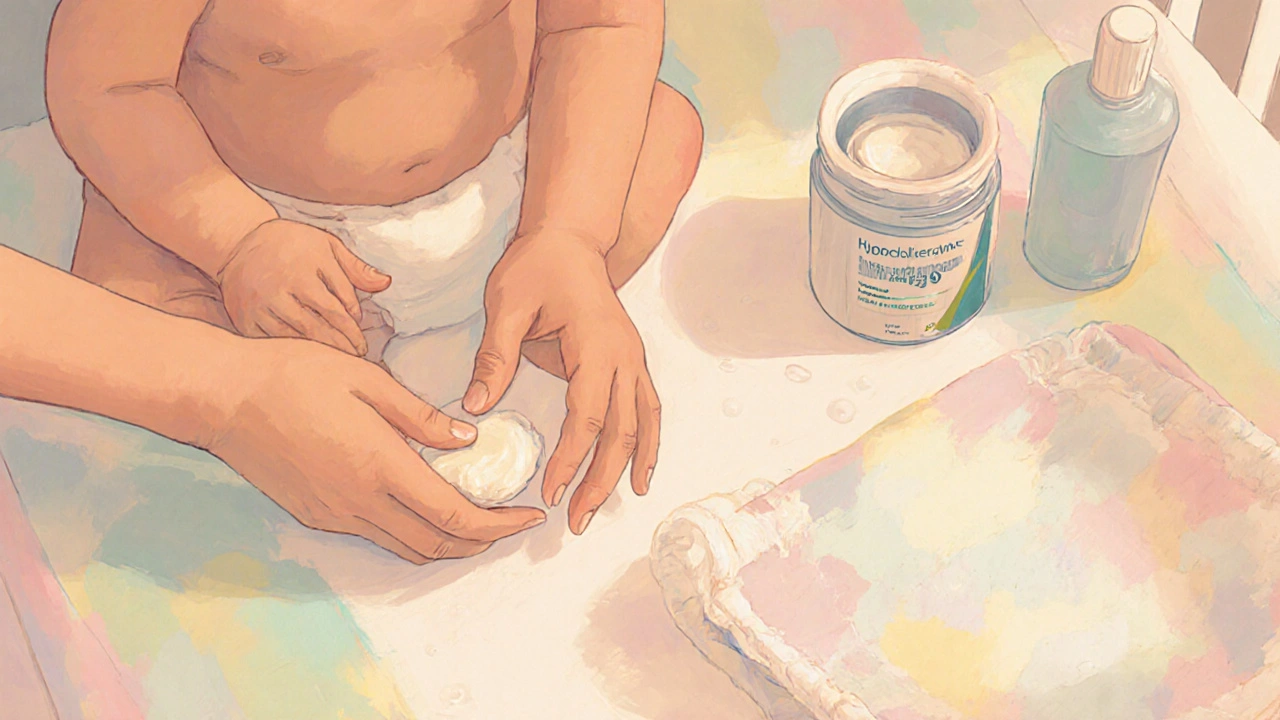
Treatment Options: When to Use the Same vs. Different Products
If the rash is mild and confined to the diaper area, a plain barrier cream is usually enough. However, when you notice any of the following, step up the treatment:
- Redness spreading beyond the diaper line.
- Visible blisters, pus, or a foul smell-signs of secondary infection.
- Persistent itching that wakes the baby at night.
In those cases, consider:
- Antifungal ointment (e.g., clotrimazole) if yeast is suspected.
- Low‑potency topical steroid (hydrocortisone 1%) for a short burst (no more than 3‑5 days) to calm inflammation-always follow a pediatrician’s advice.
- Prescription‑strength steroid or calcineurin inhibitor for severe eczema that involves the diaper area.
Never mix multiple products without guidance; layering a thick moisturizer over a steroid can reduce absorption, lengthening recovery.
Common Pitfalls and When to Call a Pediatrician
Most diaper‑rash incidents are harmless, but watch out for red flags:
- Fever over 38°C (100.4°F) accompanying the rash.
- Rapid spreading of redness or large open sores.
- Persistent rash lasting more than a week despite consistent barrier protection.
- Signs of dehydration-dry mouth, fewer wet diapers.
If any of these appear, contact a pediatrician promptly. Early intervention can prevent a simple rash from escalating into a bacterial infection or a severe eczema flare that may require systemic medication.
Putting It All Together: A Daily Care Checklist
- Check diaper every 2-3hours; change promptly.
- Wash hands before and after each change.
- Use warm water and a soft cloth; avoid wipes with alcohol.
- Pat skin dry-no rubbing.
- Apply a thin layer of barrier cream right after cleaning.
- For eczema‑prone babies, moisturize twice daily with a fragrance‑free cream.
- Inspect skin at bedtime for early signs of redness or dryness.
Following this routine reduces the chance of both diaper rash and eczema flare‑ups, keeping your baby comfortable and happy.
Frequently Asked Questions
Can diaper rash turn into eczema?
Diaper rash itself does not cause eczema, but a compromised skin barrier from frequent rashes can make a baby more susceptible to eczema. If you notice persistent dry patches after a rash heals, it could be early eczema.
Is it safe to use a steroid cream on a diaper rash?
A low‑potency steroid like hydrocortisone 1% can be used for a short period (max 5 days) if the rash is stubborn and the pediatrician approves. Avoid long‑term use, especially in the diaper area, because it can thin the skin.
Why does my baby’s skin stay red after the diaper is removed?
Lingering redness often means the skin barrier is still weakened. Keep the area clean, apply barrier cream, and give the skin time to recover before the next diaper change.
Can regular baby wipes cause eczema?
Wipes with fragrances, alcohol, or harsh cleansers can irritate sensitive skin and trigger eczema flare‑ups. Opt for plain, unscented, and hypoallergenic wipes or a damp washcloth.
How long should I wait before trying a new diaper brand?
Give a new brand at least a week to assess its effect. If redness appears within the first few days, it may be a sign of irritation, and you should switch back.



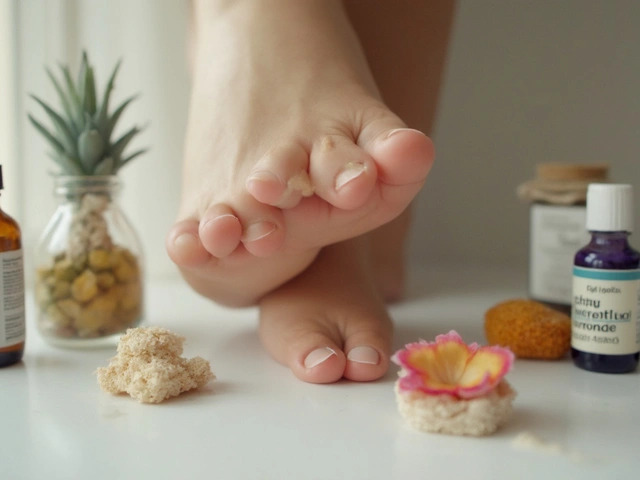

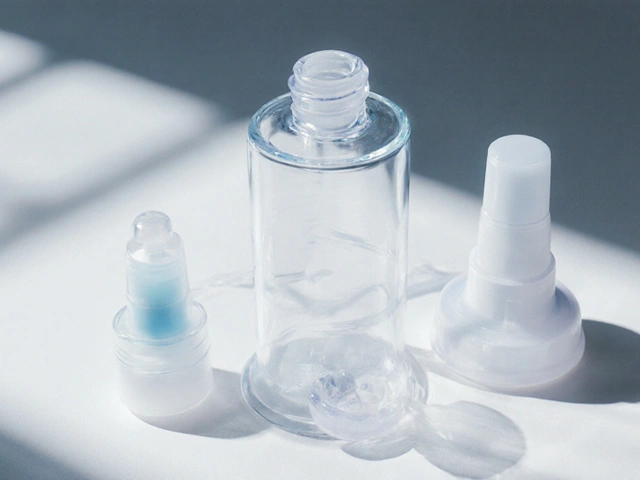
4 Comments
Mariah Dietzler
i read the guide and honestly it feels like just another list of do’s and dont’s, kinda hard to keep up w/ all the tips when you’re already sleep‑deprived.
Nicola Strand
While the article is comprehensive, it arguably contributes to the over‑medicalisation of routine infant care, encouraging parents to seek professional validation for conditions that are often self‑limiting.
Jackie Zheng
It is fascinating to consider how the skin, our largest organ, serves both as a barrier and a communicative interface with the environment; when that barrier is compromised, whether by moisture in a diaper or genetic predisposition, the manifestations-diaper rash or eczema-are merely different expressions of the same underlying physiological disruption. The stratum corneum, comprised of keratinocytes and lipids, relies on a delicate balance of hydration and acidity to remain resilient. Excess water, as found in a damp diaper, softens this layer, allowing irritants such as urine salts to penetrate and provoke inflammation. Conversely, in atopic dermatitis, mutations in the filaggrin gene diminish natural moisturizing factor production, predisposing the epidermis to dryness and pruritus. Both pathways converge on cytokine release, recruiting immune cells that amplify redness and itch. Thus, while the clinical presentations differ in distribution and chronicity, the pathophysiological cascade shares common nodes. Intervention, therefore, should aim not only at symptom relief but also at restoring barrier integrity through emollients, barrier creams, and avoidance of irritants. Moreover, recognizing the psychosocial impact of persistent itch-particularly on sleep-underscores the need for holistic care that includes parental education and support. In practice, a stepwise approach that begins with frequent diaper changes, gentle cleansing, and barrier application can resolve most diaper‑related eruptions within days. When lesions persist beyond this window, especially with oozing or fissuring, a clinician’s assessment becomes essential to rule out secondary infection or evolving eczema. Ultimately, the article serves as a valuable checklist, yet the deeper lesson lies in appreciating the skin’s dynamic equilibrium and the subtle interplay between environmental factors and genetic predisposition.
Tammie Sinnott
Here's the quick science: zinc‑oxide creates a waterproof seal while also soothing inflammation-so slap that on after every change and you’ll cut out most rash episodes before they even start.
Write a comment